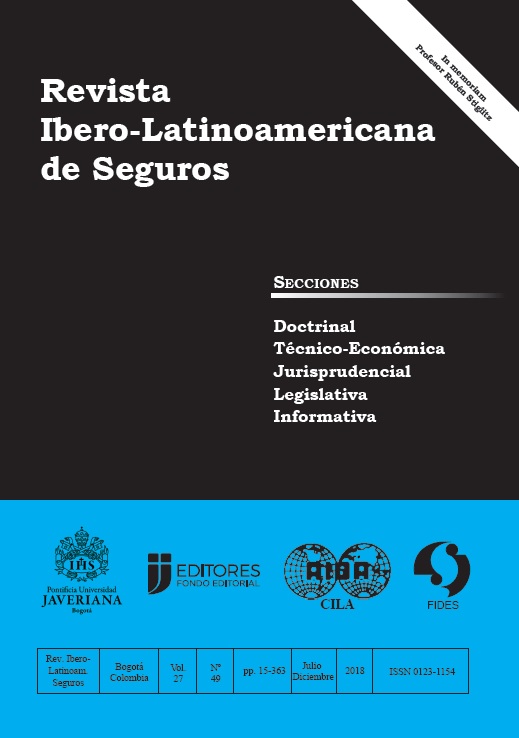Abstract
The strong diversification of potential markets has implied in recent years a significant increase in the volume of transactions and, as a consequence, the need to achieve a better and deeper knowledge of each of the traditional industries. In this sense, efforts have focused on improving the conceptualization of transferable occurrences, which has resulted in new categories of insurable risks, but always in a mostly commercial context in terms of taylor made responses, which for the rest of the industry it translates into regulatory, normative and contractual efforts that often do not generate timely reactions with respect to market expectations. In this scenario, it is valuable to have a dynamic vision of insurable risk, which allows ex ante to internalize conditions that can support automation in underwriting atypical risks as if they were traditional risks.
BAEZA O., GONZALO (2008) “Tratado de Derecho Comercial”, Tomo III. Legal Publishing, Santiago, Chile. Pp. 1644 y ss.
BAEZA P., SERGIO (1994) “El Seguro”. (Santiago, Editorial Jurídica, Tercera Edición).
BARRIENTOS, FRANCISCA (2017) “La Evolución judicial del concepto de consumidor”, artículo académico de iniciación proyecto FONDECYT N°11140516. Documento académico, curso Derecho Civil, Universidad Diego Portales. Santiago, Chile.
CONTRERAS S., OSVALDO (2002) “El Contrato de Seguros” (Santiago, Editorial Jurídica de Chile)
BARRIENTOS Z., MARCELO (2017) “Nuevos Deberes precontractuales de información en los certificados de cobertura provisorio, definitivo y la propuesta del contrato de seguro”. Revista de Derecho, Universidad Católica del Norte, Sección Estudios, Año 22, N°1, 2015, pp. 65-144. (La Serena, Chile).
CALATAYUD P., ENDINA y ESCRIBANO P., SANTIAGO (2008) “La Importancia de los Seguros Agrarios como motor del desarrollo rural y su necesidad de adaptación a los cultivos sociales”. Estudio disponible en Ministerio de Agricultura, Pesca y Alimentación de España, Biblioteca on-line: www.mapama.gob.es/es/.../Calatayud_Seguros_tcm30-103390.pdf.pp pp. 4 y ss.
CARVAJAL A., LORENA Y MAYER L., LAURA (2015) El Nuevo Fraude de Seguros. Artículo académico, Revista de Derecho de la Universidad Católica del Norte, Chile. Págs. 280 y ss.
CISNEROS-ZEBALLOS, LUIS (2017) La Nanotecnología para la prevención y descontaminación de patógenos en productos frescos. Ponencia, IX Congreso Iberoamericano de tecnología, postcosecha y agroexportaciones. Santiago, Chile. Diciembre, 2017. Facultad de Ciencias Agronómicas de la Universidad de Chile en conjunto a INIA (Centro de Investigaciones Agropecuarias).
GORSIRA, MADELIJNE; STEG, LINDA; DENKERS, ADRIAAN; AND HUISMAN, WIM (2017) Articulo académico. Administrative Sciences Jorurnal, N°8, año 2018. Mdpi.
MALCON, CLARK (1994): “The law of insurance contracts” (London, Lloyd’s of London press ltd, Second Edition).
TAPIA R., MAURICIO y VALDIVIA O., JOSE MIGUEL (2002) “Contrato por Adhesión: Ley 19.496”. Editorial Jurídica de Chile. Santiago, Chile. Pp 59 y ss.
VEIGA COPO, ABEL (2016) “Tratado del Contrato de Seguros”. Editorial Thomson Reuters-Civitas. Madrid, España.
ZORNOSA P., HILDA (2009)”El Riesgo Asegurable y los riesgos Emergentes de las nuevas tecnologías”. Revista de Derecho Privado. Universidad del Externado de Colombia. N° 17, año 2009, pp. 141 a 173.
BIBLIOGRAFÍA DE CONSULTA GENERAL
BARRIENTOS C., FRANCISCA (2013) “Una Mirada al silencio y la aceptación en los contratos por adhesión con consumidores a partir del caso Cencosud”. Cuadernos de análisis jurídico, Colección de Derecho Privado VIII, Ediciones Universidad Diego Portales. Santiago, Chile.
BARRIENTOS Z. MARCELO (2015) “El deber precontractual de información en el contrato de seguro, un producto financiero y de consumo. estudio de sus fuentes”. Revista Chilena de Derecho, Vol. 42 N°2, pp. 423 – 451. Santiago, Chile.
CONTRERAS S., OSVALDO (2005) “Derecho de Seguros” (Santiago, Editorial Thomson Reuters, Chile)
This journal is registered under a Creative Commons Attribution 4.0 International Public License. Thus, this work may be reproduced, distributed, and publicly shared in digital format, as long as the names of the authors and Pontificia Universidad Javeriana are acknowledged. Others are allowed to quote, adapt, transform, auto-archive, republish, and create based on this material, for any purpose (even commercial ones), provided the authorship is duly acknowledged, a link to the original work is provided, and it is specified if changes have been made. Pontificia Universidad Javeriana does not hold the rights of published works and the authors are solely responsible for the contents of their works; they keep the moral, intellectual, privacy, and publicity rights.
Approving the intervention of the work (review, copy-editing, translation, layout) and the following outreach, are granted through an use license and not through an assignment of rights. This means the journal and Pontificia Universidad Javeriana cannot be held responsible for any ethical malpractice by the authors. As a consequence of the protection granted by the use license, the journal is not required to publish recantations or modify information already published, unless the errata stems from the editorial management process. Publishing contents in this journal does not generate royalties for contributors.



